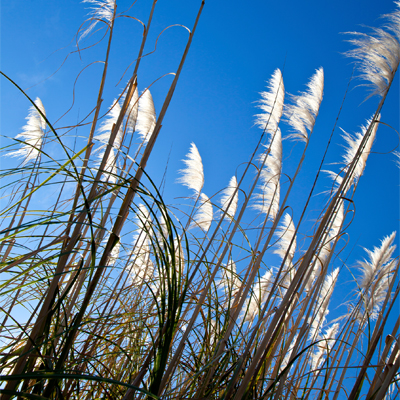
Grasses can add movement and grace to a windy garden.
Gardens in coastal regions, exposed locations, or wind-tunnel valleys can all experience an excess of wind. Blustery conditions can make even the sunniest day in the garden too cold and miserable to enjoy, and frequent strong winds can easily take their toll on the wrong kinds of plant life.
With a little planning though, it is possible to create an excellent, attractive garden in a windy location.
Create shelter
Naturally, you'll want to create some shelter to give you, your family, and your plants some relief from the wind. Semi-permeable shelters are best, as solid walls only divert the wind and create more turbulence. It's generally much better to try and disperse the wind than to try and stop it.
Shelter belts and windbreaks
A shelter belt (also called a windbreak) can protect a surprisingly large amount of garden for its size. Typically, if the wind break is wide enough, it can protect for a distance six times its height.
It takes time and money to establish an effective shelter break. Ideally, you'll want an intimate knowledge of the strength, direction and behaviour of the prevailing winds – which may require you to live in the house for a little while first.
Appropriate plants for windbreaks
Once you've established the best position for the windbreak, it's time to get planting. As discussed above, it's better to create a barrier that's slightly permeable, with an irregular surface. Mixed beds with staggered plantings are therefore ideal, and have the added benefit of introducing variety and interest to the garden.
Some suggestions for plants that look great and can help build an impressive wind break include the red-flowering gum, woolly tea-tree, spinning gum, and white peppermint. If you're near the sea or frequently have hot, dry northerlies, you'll want to consider this in your plant selection.
For the best advice, talk to your local nursery – they can recommend plants that will thrive in the conditions where you live.
Mounds and banks
A mound or bank of earth can also be effective in diverting the wind. Unlike a solid wall, a mound lifts the wind up naturally, leaving a sheltered area in its lee. Mounds require a bit more room and investment (moving earth can be expensive), but they fit in perfectly in garden designs that favour a more natural look.
Choose wind-loving plants
For certain gardens, the wind is just unavoidable – in which case, the best approach is to go with it and design with wind-loving plants. It may take an adjustment in your thinking, to put aside dreams of delicate blossoms and luscious leaves, but these plants have a charm all of their own.
Wind-loving trees include things like Banksia integriofia (coastal banksia), brachychiton acerfolius (illawarra flame tree), and the various bottle brushes, although to establish what's best for your garden, it's definitely worth a chat with someone at your local plant nursery.
Plants with form
Wind can create marvellous shapes out of plants – so much so that the creators of many Japanese and Chinese gardens seek to mimic them. Ground-hugging conifers, twisted pines, and sturdy mini-acers can all contribute to a garden where form is the basis of the aesthetic.
Obviously this is a fairly difficult effect to plan, and will depend on they types of trees you plant and the severity and frequency of the wind.
Plants that move
Some plants really to seem to love being tossed about in the wind. Think of tussock flipping up its skirts in the breeze or pampas grass throwing around its lovely plumes. Some species of eucalyptus are wind-tolerant and create a beautiful, sparkling spectacle when the breeze picks up.
An deliberately 'animated' garden is a spectacular way to take full advantage of the wind.
Ensure safety through pruning
While you want an appealing garden that you can enjoy, the first priority must be safety. Wind can bring down overhanging branches and even whole trees, damaging property and injuring people. A consultation with a qualified arborist can identify any limbs or trees that might pose a danger to your property and offer a service to remove these in a safe manner.